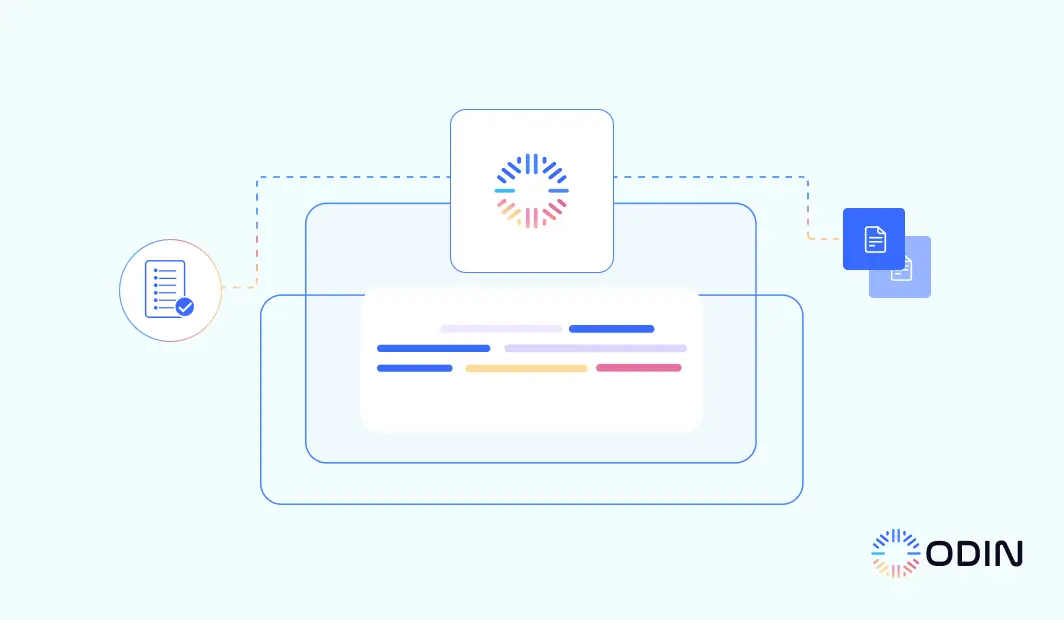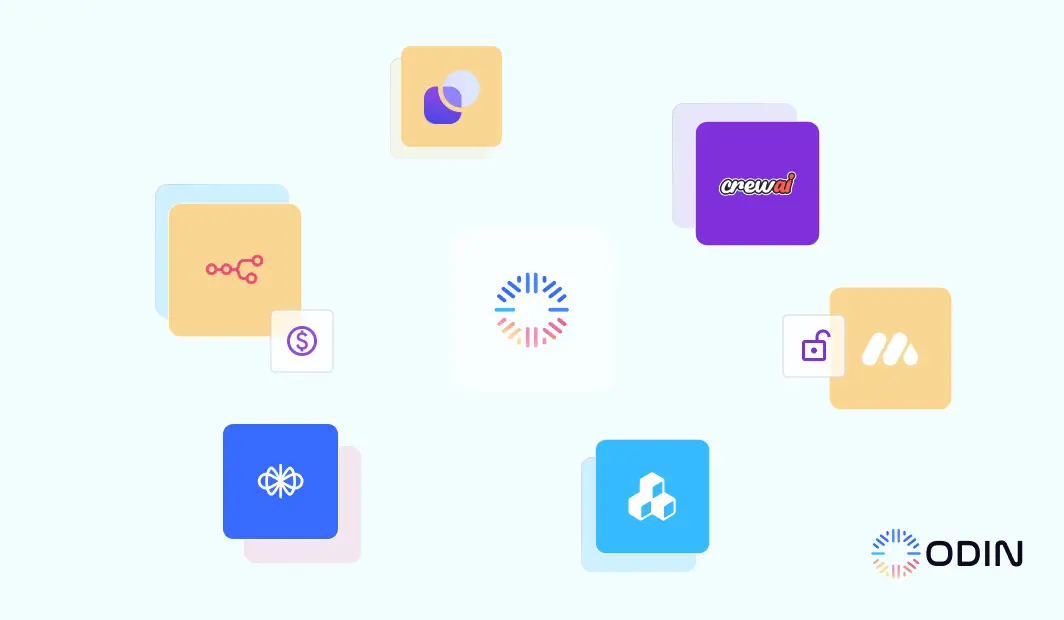How much time is your team wasting on manually processing and organizing documents? Businesses need intelligent systems that not only manage documents but also extract valuable insights to fuel decision-making.
With document analysis AI, you can turn your document repository into a dynamic knowledge base that provides real-time insights and solutions.
Odin AI automates the entire process—from scanning and classifying documents to delivering actionable insights through an intuitive AI chatbot.
This article will explore how Odin AI can revolutionize document management, helping your business build an internal knowledge base that improves operations and empowers your team with fast, reliable information.
Find what matters fast—try Odin AI today!
What is Document Analysis?
Document analysis refers to the process of examining documents to extract valuable data and insights. Traditionally, this work was done manually, which was often slow and prone to error.
With AI, document review tools make document analysis faster and more accurate. These tools can:
- Automatically scan documents
- Classify them into categories
- Extract key data
This automation cuts down on manual labor, enhances accuracy, and significantly improves efficiency in managing document workflows.
What is an AI Document Knowledge Base?
An AI document knowledge base is an advanced system that uses artificial intelligence to analyze and categorize company documents, extract meaningful data, and compile this information into a searchable, interactive knowledge hub.
The system analyzes documents, processes various file formats, and organizes them into a coherent and accessible resource.
This includes:
- Sorting and classifying documents
- Generating concise summaries of key insights
- Creating an accessible database of company knowledge
By building a document knowledge base, AI can also serve as a virtual assistant for your employees. It can provide instant answers and relevant information based on company documentation.
Upgrade your knowledge management with an AI document base—try Odin AI now!
Recommended Reading:
Odin’s AI Powered Knowledge Base: Revolutionizing Information Management
3 Ways to Improve Your Operations Using AI for Document Analysis
Here are three ways to integrate AI into your operations, so you manage documents more effectively while boosting productivity and compliance.
1. Build an AI-Powered Knowledge Base
The best way to conduct AI for document analysis is through Odin AI’s knowledge base, which allows your business to centralize and organize company documents. This makes information accessible to all employees.
Through machine learning (ML) and natural language processing (NLP), Odin AI can scan, classify, and extract data from documents.
This creates an intelligent system that answers queries instantly. Providing quick access to accurate and up-to-date information saves time and improves decision-making across departments.
2. Automate Document-Heavy Processes
Automating routine tasks, such as data entry, invoice processing, and contract management, helps eliminate manual labor and reduces the risk of human error.
AI-powered tools can analyze documents to support workflows, handle large volumes of data, categorize files, and extract key data points efficiently.
For finance teams, it’s important to understand which processes to automate and which to manage manually.
Automation improves operational efficiency and allows employees to focus on more strategic work while guaranteeing higher accuracy in document processing.
3. Improve Compliance and Data Security
With AI for document analysis, businesses can automate compliance tasks and make sure that all documents are handled securely.
AI systems can monitor and classify sensitive information. This guarantees compliance with regulations like GDPR and HIPAA.
With these tools that secure and track document changes, organizations can:
- Improve data governance
- Maintain audit trails
- Reduce the risk of regulatory violations
By leveraging AI to analyze files, businesses can guarantee compliance while saving time and reducing human error, even when dealing with long documents and complex regulations.
Boost efficiency with AI-driven document analysis—try Odin AI today!
Recommended Reading:
On-Premise: Why It Still Matters in 2024
How AI Document Analysis Works
AI document analysis relies on three main technologies: optical character recognition (OCR), natural language processing, and machine learning.
Optical Character Recognition (OCR)
OCR converts scanned documents or printed text into machine-readable text. For example, OCR can take a scanned invoice and turn it into digital text that AI tools can process.
OCR plays an important role in making documents searchable and editable. This contributes to your organization’s overall document intelligence by allowing AI systems to analyze and retrieve critical information from various document types.
Natural Language Processing
NLP helps AI systems understand and interpret the meaning behind the text in documents. This is useful for extracting relevant information like names, dates, and addresses from unstructured text.
This allows it to extract the most important data. With Odin’s knowledge base, NLP can be used to help your team interact with AI. It can retrieve accurate data and gain insights from your company’s documents instantly.
Machine Learning
Machine learning allows AI systems to improve over time. As more documents are processed, the AI becomes better at:
- Identifying patterns
- Classifying documents
- Detecting anomalies
ML helps AI tools become more accurate with each use. By leveraging Odin’s knowledge base, your AI document analysis improves as it learns from your company’s data.
Recommended Reading:
From Zero to Hero: Setting Up AI Customer Support Projects with Odin AI
How to Implement an AI Document Analysis
Implementing an AI document analysis tool in your organization requires careful planning and a step-by-step approach.
While AI can improve efficiency, a smooth implementation guarantees that your organization reaps the maximum benefits with minimal disruptions.
Step 1: Consider Your Document Analysis Needs
Before selecting a tool, evaluate the current challenges your organization faces. Consider the volume of documents processed daily, the type of documents (invoices, contracts, legal forms), and the current pain points.
Step 2: Choose the Right AI Tool
Refer back to the features and integration needs discussed earlier. Make sure it can integrate with your existing document management systems and that it offers scalability for future growth.
Step 3: Pilot the AI Solution
Implement the AI solution on a small scale to test it. This pilot phase allows you to assess the tool’s performance on real-world data. It can also help you identify any integration issues with your existing systems.
Step 4: Train Your Team
Even the best AI tools require some level of human oversight. Make sure your team is trained to use the AI tool. They should be able to monitor its output to spot any inaccuracies or patterns that the AI might miss.
Step 5: Roll Out Across the Organization
After a successful pilot, roll out the AI tool across departments that handle high volumes of documents. Continue to monitor its performance and gather feedback to make incremental improvements in your document processing workflows.
Simplify your document processing—implement Odin AI for smarter analysis!
Recommended Reading:
Introducing Data Filtering for Smarter Document Retrieval
Applications of AI in Document Analysis
AI has a wide range of applications in document analysis. It changes how businesses across different sectors handle their documents.
From automating tasks to improving accuracy, AI solutions can optimize workflows and reduce operational costs.
Invoice Processing and Automation
Traditionally, invoices are handled manually, which is both time-consuming and prone to errors.
The system can automatically extract relevant data, such as:
- Vendor names
- Invoice numbers
- Payment terms
- Due dates
AI tools can also validate this data against purchase orders or contracts to make sure everything is consistent.
Automating invoice processing improves cash flow management and reduces the likelihood of errors like duplicate payments or incorrect amounts.
With advanced integrations, such as SQL-based solutions, businesses can further improve their financial automation and data accuracy.
Employee Onboarding and Contract Management
AI tools can extract data from employment contracts. This includes:
- Salary details
- Terms of employment
- Benefit clauses
AI can also automate the classification and organization of documents related to employee onboarding. This guarantees that nothing is missed.
In terms of contract management, AI helps monitor contract terms. It flags upcoming deadlines or potential violations to make sure that organizations stay compliant.
AI can also assist with internal IT support by automating helpdesk tasks.
Insurance Claims Processing
Insurance claims involve large amounts of paperwork. This includes:
- Policy details
- Claim forms
- Supporting documents
AI can simplify and speed up this process by automatically extracting data from claim documents, such as policy numbers, dates of incidents, and claim amounts.
AI tools can also validate the data against the insurance policy to guarantee that claims meet the required conditions.
They can also flag any inconsistencies or potential fraud. This helps insurers to process claims more efficiently and accurately.
Legal Document Review
AI for document analysis can automate the review of contracts and legal documents by legal professionals. This includes the process of legal document review.
AI can extract and analyze:
- Key clauses
- Legal precedents
- Terms from complex legal documents
This is beneficial during legal document review, where accuracy and speed are important for timely decision-making.
Legal professionals who adopt AI for legal document review can shift their focus from administrative tasks to more strategic decision-making.
AI tools can also be applied to customer-facing roles, such as chatbots in e-commerce, where they improve customer experience by providing quick responses and personalized interactions.
Recommended Reading:
Exploring the Difference Between Chatbots and Conversational AI
Boost Your Document Efficiency with Odin AI
Odin AI is the best solution for teams aiming to improve their document processing.
With features like AI-powered data extraction, advanced document classification, and easy integration with your existing systems, it eliminates the hassle of manual document management.
Odin AI can:
- Connect all your enterprise data in one safe, fast repository
- Distinguish context across different types of information (how-to guides, walkthroughs, policies, manuals…)
- Understand and interpret context and deliver accurate responses
- Retrieve and deliver the most relevant information using RAG
- Add related questions to documents and rank important information based on priority
Whether you’re dealing with invoices, contracts, or legal documents, Odin AI helps you handle them all efficiently in one platform.
Try Odin AI today and discover how AI-powered document analysis can boost your team’s productivity and accuracy.
Have more questions?
Contact our sales team to learn more about how Odin AI can benefit your business.
FAQs About AI for Document Analysis
Document intelligence refers to the use of AI to analyze and understand data from various document types. It helps organizations automate tasks like extracting document information, identifying patterns, and providing actionable insights from documents.
AI systems can classify documents based on pre-set categories such as invoices, contracts, or legal forms. By using machine learning and natural language processing, AI tools can sort large volumes of documents quickly and accurately.
Key features include OCR for digitizing text, NLP for extracting document information, machine learning for improving accuracy over time, and documents chat capabilities for team collaboration.
Yes, AI can manage the entire document review process. This includes analyzing, classifying, and extracting data from txt files and other formats. AI guarantees every section of a document is processed accurate.
Document intelligence uses AI algorithms to extract relevant document information from an entire file. This guarantees that no important details are missed and improves accuracy by reducing human error in large-scale document reviews.
AI systems can automatically detect and classify sensitive document information within files. This guarantees compliance with regulations like GDPR and HIPAA by flagging potential issues.
Yes, most AI-powered tools, like Odin AI, integrate directly with existing document management systems. This allows businesses to automate workflows and manage documents chat and collaboration features without overhauling their current infrastructure.
Absolutely. AI-powered document analysis is scalable and can grow with your business. It is equally effective for small teams and large enterprises, handling increasing volumes of txt files and other document types efficiently.

